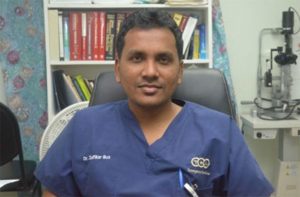…EMS Director urges Good Samaritans responding to road accidents
By Rehana Ahamad
GUYANESE are known to be quite helpful by nature and in times of tragedies, we tend to shatter all superficial barriers in our bid to provide assistance to victims of adversity.
However, while intentions may be admirable and well-placed, the responses from Good Samaritans may not always be good for the victims, especially those injured in road accidents. This is why Dr. Zulfikar Bux is pushing aggressively for the expansion of Guyana’s National Emergency Medical Services (NEMS).
“If we had enough coverage, we would have asked members of the public to take a step back and allow trained first-aid responders to tend to the emergencies,” the national EMS Director told the Sunday Chronicle during an interview.
In an ideal situation, emergencies of this nature would have been responded to by the police, emergency medical responders, and the fire service, simultaneously. However, with Guyana’s EMS being just about four years old, this is not yet being done.
A Facebook video of an Old Year’s Day crash at Coverden, East Bank Demerara, showed public-spirited citizens removing injured persons from the wreckage and placing them into the tray of a nearby canter truck for transport to a medical institution. The victims were all taken to the hospital for treatment; however, one of the victims — a young mother — Danata Damon, succumbed to her injuries a few hours later.
Medical practitioners have often warned that providing hurried responses to cases of accidents may not always be best, because even though it may result in swift transportation to a medical institution, the untrained handling of victims can result in them sustaining further injuries, many of which can lead to life-long disabilities — or even death.
Should these unfortunate consequences prevail, however, persons providing assistance are protected by the Good Samaritan Act. This ultimately and generally gives basic legal protection from liability of unintended harm caused by the assistance they would have rendered. Because vehicular accidents have become so very common, it is likely that almost every Guyanese would have at some point in their lives, witnessed an accident, or at least the aftermath of one. The involvement of public-spirited citizens is therefore critical and necessary in order to save lives.
“We don’t have enough coverage, so we still rely on members of the public to be good first responders,” Dr. Bux indicated. He, however, advised that they proceed with caution.
ASSESS THE SITUATION

First and foremost, Dr. Bux stressed the need for persons to assess the situation before running to provide assistance.
“Scan for threats such as fires, exposed wires and fuel leaks…then if there is no need for immediate action, a call should be placed promptly to emergency services,” the doctor said.
He explained that even though Guyana’s EMS is not as advanced as many would hope, it has still successfully provided assistance to thousands of Guyanese.
“As it is, we have three ambulances serving the East Bank of Demerara,” Dr. Bux noted.
When one attempts to become a licensed driver, he or she is required to take a theoretical course, followed by a driving practical. In the lectures, potential drivers are briefed on providing first aid. It is encouraged that priority assistance be given to those who are conscious, especially if they are bleeding.
In this case, stopping the bleed becomes the most critical task. As it relates to unconscious victims, it is important to check for breathing and give Cardiopulmonary Resuscitation (CPR), or as is commonly known in Guyana, ‘mouth-to-mouth respiration.’ If a Good Samaritan does not know how to perform CPR, he or she is advised against even attempting it, since it can cause the victim more injuries.
OVER-THE-PHONE ASSISTANCE
Asked about the availability of over-the-phone assistance by trained professionals to untrained responders, Dr. Bux said that this is a component of the EMS that is being examined, and is likely to be implemented as the service expands.
“As it is, the service is new and most of our EMTs are quite young, so we still have to bring them to a standard where they are able to give assistance on the phone, and not just when they get to a scene,” Dr. Bux told the Sunday Chronicle.
The EMS Director said that the plan is to provide coverage to Guyana’s road population, with adequate staff and resources to be able to respond within 15 minutes to any accident scene along the country’s major carriageways.
“I sometimes fantasise about the day when every Guyanese can have emergency access to paramedics anywhere in Guyana by calling the emergency hotline. I am still optimistic we will get there and I’ll do all that I can to achieve this goal,” Dr. Bux said.
As for the hinterland regions, air and water ambulances remain most effective.
“That process needs a more collaborative effort, but we have the technical know-how to support such a system,” Dr. Bux added.
He said that with the emergence of a thriving oil-and-gas sector, Guyana’s developments are likely to be rapid, making the need for an effective EMS system even more obvious. Dr. Bux is optimistic that Guyana can still have National EMS coverage by 2025.



.jpg)








